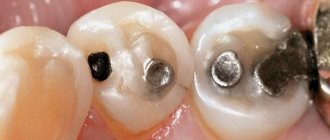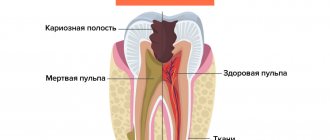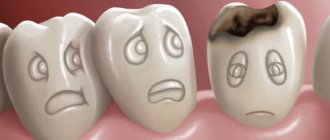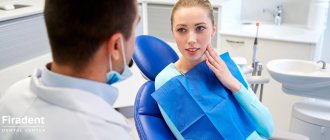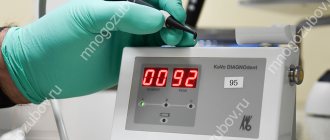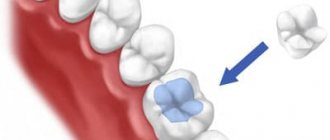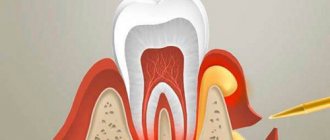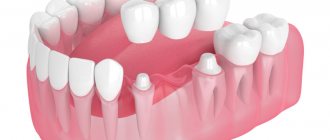Treatment of non-carious dental lesions is the elimination of congenital and acquired pathologies in the development of enamel and dentin, which are non-infectious dental diseases. The destruction of enamel and dentin that progresses with age worsens the appearance of teeth and creates problems with chewing food, which is why it is so important to visit the dentist in a timely manner, i.e. at least 2 times a year to start treatment at an early stage. This group of diseases includes hypoplasia and hyperplasia of enamel, as well as erosion, wedge-shaped defect, pigmentation, dental trauma, hyperesthesia, necrosis of hard tissues.
- Hypoplasia
- Hyperplasia
- Hyperesthesia
- Wedge-shaped defect
- Hard tissue necrosis
- Pigmentation
- Erosion
- Fluorosis
- Injuries
- Advantages of treatment at GrandMed
- On a note
Non-carious dental lesions are a large group of diseases of a non-infectious nature that lead to the destruction of hard dental tissues. The destruction of enamel and dentin, which rapidly progresses with age, worsens the appearance of teeth and creates problems with chewing food. Non-carious lesions are diagnosed during an examination of the oral cavity, and treatment, the effectiveness of which directly depends on the timeliness of contacting a specialist, is aimed at restoring the mineral composition of tissues and eliminating the aesthetic defect of the dentition.
Dental lesions are divided into two groups:
- Congenital or occurring before teeth eruption (enamel hypoplasia and hyperplasia).
- Acquired or occurring after teething (erosion, wedge-shaped defect, pigmentation, dental trauma, hyperesthesia, necrosis of hard tissues).
About half of people in the older age group (45–65 years) suffer from acquired diseases.
Dental hypoplasia
The pathology is manifested by underdevelopment or absence (aplasia) of tooth enamel; It can be congenital, but also develops after the birth of a child due to insufficient intake of minerals into the body. Hypoplasia itself refers to non-carious lesions of teeth, but thanks to it, excellent conditions are created in the oral cavity for the development of microbes, including those that cause caries.
Causes of hypoplasia:
- metabolic disease;
- mechanical damage to the jaw bone;
- dystrophy;
- diseases of the gastrointestinal tract;
- developmental pathologies;
- During pregnancy, the woman had: severe toxicosis, rubella, ARVI, toxoplasmosis, conflict of Rh factors, as well as premature birth and birth trauma.
Symptoms of hypoplasia
Pathology can be systemic (affects all teeth) and local (affects several teeth). In the early stages, underdevelopment of the enamel (too thin a layer or complete absence), deformation of the teeth and the appearance of grooves, yellow and white spots on their surface are noted. Painful sensations are noted during meals, and later, in the absence of treatment, the tissues are destroyed (erased) and an abnormal bite is formed.
Treatment of hypoplasia
Since underdevelopment of hard tissues and tooth decay is associated with a lack of minerals, when treating hypoplasia, it is necessary to remineralize the enamel with special preparations. To improve the appearance, teeth that have retained their normal shape are whitened, and if this is not enough, the defects are filled or prosthetics are performed. Congenital dental hypoplasia in children, in most cases, can be prevented; for this, during pregnancy, a woman’s diet must be balanced and contain sufficient amounts of vitamins D, A, C, group B, as well as calcium and fluorine. In addition, the expectant mother, in order to avoid non-carious lesions of the child’s teeth, should pay due attention to oral hygiene.
Treatment of caries in the cervical area
All video presentations
The tactics of treating cervical caries depends on many factors, but the main one is at what stage of development of the pathology treatment began.
Treatment in the early stages
In the early stages of the disease, conservative therapeutic methods are used. In particular, the treatment of caries at the stage of the appearance of a stain is reduced to saturating the surface layer of enamel with calcium. For this purpose, special remineralizing agents containing fluorine and highly active calcium are used (for example, Tiefenfluorid or ICON). Before applying such drugs, hard and soft pathological deposits are removed from the teeth.
Treatment of caries in later stages
In the later stages of the disease, treatment is reduced to filling the tooth.
The treatment program in such a situation includes the following steps:
- cleaning teeth from soft and hard pathological deposits using abrasive pastes and polishing brushes;
- determining the color of the enamel of a damaged tooth and selecting suitable filling materials;
- preparation of a carious defect, removal of all dental tissues damaged by caries;
- isolation of the dental cavity from saliva;
- treatment of the prepared carious cavity with an adhesive for reliable adhesion of the filling to the dental tissues;
- introducing filling material into the treated cavity;
- giving the tooth its physiological shape;
- grinding and polishing the filling using special burs and fine-grained discs.
Dental hyperplasia
With hyperplasia, teeth acquire an unaesthetic appearance, becoming covered with growths due to excessive formation of hard tissue. The so-called “pearl drops” reach 5 mm in diameter and consist of tooth enamel, dentin, and connective tissue. Depending on the location, there are root, coronal and cervical (main area of localization) formations.
Causes of dental hyperplasia:
- metabolic disease;
- congenital developmental pathologies;
- mechanical injuries of teeth and jaw bones;
- diseases of the gastrointestinal tract;
- disorders of intrauterine development of the fetus.
Symptoms of dental hyperplasia
Excessive formation and deposition of hard tissues on the surface of teeth is a cosmetic defect, clearly visible when the frontal group of teeth is affected; pain or discomfort is not typical for the pathology. Sometimes “drops” consisting of enamel form inside the dentin of the crown or root parts of the tooth and do not show themselves in any way.
Treatment of dental hyperplasia
If “drops” worsen the appearance of the teeth, then they are polished, thus leveling the surface and giving it an aesthetic appearance. The pathology does not require any special treatment, but since cervical growths often cause inflammation of the gums, they are removed with a diamond bur and treated with drugs containing fluoride.
Dental hyperesthesia
In most cases, hyperesthesia or increased sensitivity of teeth is not an independent disease, but a symptom of other non-carious lesions associated with changes in the structure and thinning of the enamel. The pathology is characterized by short-term acute or aching pain in one or more teeth that occurs when exposed to external irritants. Teeth with an intact pulp have increased sensitivity, both those that have lost part of their own tissues as a result of caries treatment, and those that maintain their integrity.
Causes of dental hyperesthesia:
- congenital structural features of enamel;
- thinning of enamel with age;
- exposure of the cervical part of the tooth due to receding soft tissue of the gums;
- violation of the integrity of tooth enamel by bacteria accumulating in the cervical area due to poor oral hygiene;
- mechanical damage to enamel, including hard toothbrushes and toothpastes containing coarse abrasives;
- enamel damage associated with exposure to chemically active substances that disrupt the acid-base balance (consumption of sweet and sour foods, as well as carbonated drinks);
- cracking of enamel when eating too hot or cold food;
- grinding and strong clenching of teeth (bruxism) lead to microtraumas of the enamel;
- unprofessional teeth whitening and abuse of such procedures;
- lack of calcium and phosphorus in the diet, or poor absorption of microelements due to diseases of the digestive system;
- general demineralization of the body, for example, in women during pregnancy or menopause.
Symptoms of dental hyperesthesia
Increased sensitivity is indicated by fairly severe pain that occurs as a response to any irritation. The tooth “aches” from hot and cold food, when consuming sour and sweet foods.
Treatment of dental abrasion and hyperesthesia
In case of increased tooth wear, orthodontic treatment (bite correction) is carried out, and if the patient has exposure of the cervical area due to pathological receding gums, then surgery is performed. In the case of a mild form, hypersensitivity is relieved by special toothpaste, application of fluoride-containing applications to areas with damaged enamel, as well as restoration of demineralized enamel with filling material. Prevention of hyperesthesia consists of maintaining oral hygiene (including regular professional cleanings) and a balanced diet, that is, sufficient intake of calcium, phosphorus and vitamins K, E, D. After sour and sweet foods, the mouth should be rinsed with water.
Carious lesions of teeth
Caries is one of the most common dental diseases, which is a consequence of the activity of pathogenic microorganisms. Bacteria, breaking down food debris (especially sugar), form certain types of acids, under the influence of which dental tissue is demineralized, softened and destroyed.
The rate of degeneration of dental material due to caries depends on the following factors:
- Oral hygiene. With careful care (especially before bed), food debris, plaque and pathogenic bacteria are destroyed, which helps slow the spread of carious lesions.
- Metabolic state. Depending on the health of the endocrine system, the destruction process may be slower or faster. This also includes eating disorders - with an excess of sweets in the diet, caries progresses much faster.
- Gastrointestinal health. This is due to the chemical processes of breakdown of simple carbohydrates that provoke caries.
- Presence of sleep disorders. Since the bacteria that cause tooth decay are anaerobic organisms (that is, they live without access to air), sleep disorders that cause the patient to sleep with the mouth open or snore significantly reduce the rate of bacterial growth. This group of factors is joined by an active-conversational rhythm of life, in which the patient has to talk a lot, as a result of which regular access of air in the oral cavity reduces the activity of microorganisms.
Symptoms of caries
The first manifestations of caries are white or dark spots on the tooth enamel. Most often this goes unnoticed, especially in the case of damage to distant teeth.
The next stage is increased sensitivity of the teeth to the effects of the external environment - a reaction to sweet foods, temperature changes.
In cases where caries has affected the surface of the tooth, destruction may be accompanied by sharpening of its edges, as a result of which the mucous membrane of the oral cavity next to the diseased tooth is often injured.
If caries is not treated at this stage, it will continue to destroy the tooth until it reaches the pulp, the area of soft tissue in which the dental nerve is located. This is accompanied by severe pain, with which, in most cases, the patient comes to the dentist. The sooner the patient consults a doctor, the more tooth tissue can subsequently be preserved.
Treatment of caries
Caries is treated by removing the affected tissue. To do this, the carious cavity of the tooth is opened and prepared using a drill, abrasives, laser or ultrasound. After this, the tooth is filled..
Filling allows you to restore the functionality of the tooth in case of mild to moderate destruction of dental tissues. In cases where the tooth has been almost completely destroyed, prosthetics are used.
Wedge-shaped (abfraction) defect
Non-carious lesion of teeth, in which a defect is formed on the neck of the tooth that looks like a wedge. In the early stages, a wedge-shaped defect is difficult to diagnose, since the tooth retains its structure and color, so dentists, as a rule, detect deep lesions accompanied by darkening of the tissue and pain felt by the patient while eating. Often, a wedge-shaped defect develops against the background of periodontal tissue diseases (periodontitis and gingivitis) and is usually diagnosed in older and middle-aged people, mainly on canines and premolars (small molars).
Causes of wedge-shaped defect:
- deterioration of tooth nutrition due to age-related problems with blood supply;
- metabolic disorders, including due to thyroid diseases;
- improper distribution of the load on the teeth, for example, chewing on one side;
- bruxism or teeth grinding;
- improper brushing technique;
- brushing your teeth immediately after eating acidic foods;
- increased stomach acidity;
- gum diseases, including gingivitis and periodontitis.
Symptoms of a wedge-shaped defect
The disease is non-carious in nature, that is, it is not associated with pathogenic microflora, and therefore develops rather slowly. The enamel in the gingival zone is mainly affected: in the early stages, the strongest tissue of the human body becomes thinner with the formation of a pit, but remains smooth and retains color. Gradually, the enamel is completely destroyed, dentin is exposed, and the teeth react sharply to sour and sweet, hot and cold foods, “aching” pain also appears when brushing your teeth.
Treatment of wedge-shaped defect
In case of significant damage, they resort to filling the defect cavity with a material that has a certain degree of elasticity. If the tooth is not strengthened in this way, its supragingival part may break off. Another effective way to protect a tooth with a wedge-shaped defect is to perform microprosthetics and install a veneer on it. In case of a small depth of the defect, remineralization (saturation with calcium and fluoride) of the enamel is carried out in a dental clinic. It is recommended to maintain the mineral composition of teeth yourself using toothpaste and mouth rinse selected by a specialist. In addition, it is important to master the correct technique for brushing your teeth and avoid using hard-bristled brushes, as well as toothpastes with abrasives, that injure enamel and gums.
Tooth erosion - symptoms and treatment
Therapy must be comprehensive, since the doctor must not only eliminate the hard tissue defect, but also influence its causes, otherwise the teeth will continue to decay. For example, if erosion is caused by the action of acids, then first of all it is necessary to adjust the patient’s lifestyle and eating habits. Foods containing acids should be excluded from the diet. You need to make it a rule to perform oral hygiene after every meal. The dentist should also choose a toothbrush with optimal hardness and tell you how to properly brush your teeth.
If dental pathology is caused by other diseases, then during the treatment process the dentist has to work closely with doctors of other specialties, for example, endocrinologists or gastroenterologists.
The method of closing the defect is chosen depending on the location of the erosion. If the defects are located on the occlusal (chewing) surfaces of molars and premolars, it is necessary to focus on strength, if on the anterior surface of the incisors, on aesthetics. Composite materials are used to restore the integrity of teeth. Dental tissue preparation is usually performed to a depth of up to 0.5 mm. To restore the front teeth, you can use ready-made overlays made of composite materials (veneers). They are thin and have good aesthetics. With their help, you can eliminate even noticeable defects and make your smile attractive.
If the chewing surfaces of the teeth are significantly damaged or erosion is combined with other dental diseases, then crowns are used for restoration. Metal-ceramics are excellent for chewing teeth. The material has an optimal balance of strength, aesthetics and price. If erosion is combined with increased abrasion due to bruxism, occlusal splints are used [2].
To improve the patient’s quality of life, it is necessary not only to eliminate the defect, but also to reduce tooth sensitivity. For this purpose, drugs are used that affect nerve endings or close dentinal tubules. The doctor carries out appropriate procedures in the dental office, and also selects dental care products that reduce sensitivity. Toothpastes with a high content of calcium and fluoride are suitable for such patients. These elements partially cover the dentinal tubules, which gradually reduces tooth sensitivity. Dental offices use laser technology to reduce tooth sensitivity. You need to understand that complex treatment is necessary to obtain the effect; home remedies alone are not enough.
Necrosis of hard dental tissues
Necrosis or death of hard tissue is a lesion of enamel and dentin, manifested by the formation of multiple defects on the surface of the teeth. The disease is non-carious in nature, develops after teething and is equally common in men and women. Necrosis causes a change in cell structure, which manifests itself in the destruction of hard tissues and pulp vessels. For successful treatment, it is important for the dentist to establish the cause that caused the necrosis, so the patient must undergo a comprehensive examination, including an endocrinologist and gastroenterologist.
Causes of necrosis of enamel and dentin:
- hormonal imbalance;
- digestive disorders;
- work in hazardous industries and contact with toxic substances;
- exposure, including radiological treatment
Symptoms of necrosis of hard dental tissues
At the early stage of this disease, the enamel loses its shine and becomes covered with chalky spots, which gradually acquire a dark brown color. The matter is not limited to a change in color - the hard tissues under the spots soften, destruction of enamel and dentin occurs, which ends in the destruction of the supragingival part. The process of necrosis involves several teeth at once, which become sensitive to external irritants. The foci of the disease are located, as a rule, in the cervical part.
Treatment of hard tissue necrosis
The pathology is non-carious in nature and its symptoms resemble erosion and a wedge-shaped defect. In the early stages, calcium-containing preparations are applied to strengthen hard tissues and reduce sensitivity. In case of severe damage, orthopedic treatment cannot be avoided, during which the affected tissue is removed and the tooth is covered with a crown. At the same time, disease therapy and the elimination of negative factors that led to the development of necrosis must be carried out.
Treatment of wear of hard dental tissues
Normalization of occlusal relationships is the first and most important stage. Measures to correct occlusion include restoration of the occlusal surfaces of teeth, orthodontic treatment, and more.
Treatment of bruxism requires a comprehensive interdisciplinary approach [27]. Depending on the severity of manifestations and causes, psychiatrists, neurologists and physiotherapists take part in treatment. There is a need to manufacture an occlusal splint or mouth guard and use intraoral devices.
Therapeutic and orthopedic treatment methods are used to eliminate hard tissue defects. When restoring the vestibular surfaces of teeth, the leading requirement is aesthetics; for the occlusal surfaces, mechanical strength is the main requirement.
With increased abrasion, preference is given to orthopedic treatment methods - crowns and onlays.
In the case of cervical defects, it is recommended to prepare hard tissues to a depth of 0.5 mm, form a bevel, and restore with composites or GIC [28]. The enamel is ground around the defect using fine-grained diamond burs coated with 80 microns (with a red marking strip); some authors recommend reducing the enamel etching time to 5 seconds. [29].
An innovative method for closing defects is the use of direct composite onlays, manufactured in a factory. For example, COMPONEER manufactured by Coltene/Whaledent (Switzerland) - thin composite onlays (0.3-0.7 mm) with a uniform surface - allows you to close defects in the hard tissues of teeth [30] (Fig. 9a - d).
Rice. 9a. Patient 1 before treatment.
Rice. 9b. Patient 1 after treatment: metal-ceramic bridges in the area of the lateral group of teeth, Enamel White Opalescent composites on teeth 14,13,12,11, base A1/B1; lower incisors - restorations from Synergy D6.
Rice. 9th century Patient 2 before treatment.
Rice. 9y. Patient 2 after treatment: Enamel White Opalescent compositors on teeth 12, 11, 21, 22, S0 Miris base and W paint on teeth 12 and 21.
Pigmentation of teeth
A non-carious pathological condition in which teeth become brown, yellow, gray, pink, black, red or another unusual color or shade. In most cases, pigmentation develops against the background of demineralization of the enamel, accompanied by hypoplasia and hyperesthesia. Pigmentation occurs under the influence of general (diseases, medications) and local (smoking, food colorings) factors and occurs in 85% of people, more often in men than in women. Treatment of this non-carious dental disease involves regular professional cleaning and whitening, but often the only way to restore the aesthetics of the dentition is prosthetics.
Causes of tooth pigmentation:
- demineralization of enamel;
- chips and other injuries to hard dental tissues;
- poor oral hygiene;
- treatment using iodoform and resorcinol-formalin, as well as “silvering” of teeth;
- rupture of the neurovascular bundle (pulp);
- smoking;
- taking certain medications and foods with added food coloring;
- hemolytic disease;
- uroporphyria;
- Excessive production of pigment in the body.
Pigmentation, like many other non-carious lesions, develops not only after, but also before teething. Thus, pigmentation in a child is often a consequence of the mother taking tetracycline antibiotics during pregnancy, which, penetrating the placenta, are deposited in the bones and tooth buds. Since the composition of dentin and enamel remains virtually unchanged over time, one cannot expect that yellow-brown pigmentation will disappear with age.
Symptoms of tooth pigmentation
The natural color of enamel is milky white, all other options indicate pathological pigmentation. The color of teeth affected by non-carious diseases varies. Thus, with a hemolytic disease accompanied by bilirubin deposition, the teeth are painted in various shades of gray, blue, green and brown, while “tetracycline” pigmentation is yellow-gray. Red staining is characteristic of uroporphyria, and gray staining is characteristic of pulp necrosis. In cases of exogenous pigmentation (associated with external factors), enamel and dentin are colored dark brown by nicotine, and pink by resorcinol-formaldehyde paste (not currently used in dentistry).
Treatment of tooth pigmentation
If, based on the patient’s complaints, clinical examination data and the results of additional studies (radiography and thermography), pathological pigmentation of the teeth is diagnosed, then treatment begins immediately. The therapy consists of sanitation of the oral cavity, including thorough removal of dental plaque (professional cleaning with ultrasound and using the Air Flow air-abrasive system). In case of deep pigmentation, intracanal and external bleaching is carried out using special preparations. However, not all types of pigmentation are eliminated by bleaching. Thus, the procedure will not eliminate tetracycline discoloration and color changes that appear as a result of oxidation of metal pins installed in the channels and silver amalgams. In these cases, pigmented teeth are covered with crowns and veneers (if their condition allows this). When treating non-carious pigmentation in children, consultations with a pediatrician and a genetic specialist are often required.
Non-carious lesions of teeth
This type of pathology is divided into two groups - congenital (occurring before birth, at the stage of formation of dental follicles) and acquired (occurring after teething).
Congenital diseases include:
- enamel hypoplasia (pathology of tissue development due to mineral deficiency and protein metabolism disorders) - a disease manifested in the form of a spot or depression, inside which the enamel is either absent or softened;
- fluorosis (excess fluoride in the body) - manifests itself as dullness of the enamel with yellow-brown spots and stains, as well as fragility of the hard tissues of the teeth.
Acquired pathologies of hard dental tissues include:
- pathological abrasion of teeth - progressive loss of enamel and dentin;
- erosion of hard tissues - a destruction process provoked by exposure to acids;
- enamel pathologies resulting from taking tetracycline antibiotics, which causes the enamel to become yellow or brown;
- crown fracture - mechanical damage to a tooth that is prone to destruction due to insufficient mineralization or carious lesions.
Treatment
Congenital pathologies are most often treated with drug therapy that compensates for the excess or deficiency of chemical elements in the body. Hypoplasia and erosion are eliminated by multiple filling of areas of softened enamel. Enamel defects are whitened using modern methods (using abrasive or chemical agents, ultrasound or laser). In case of pathological abrasion, fillings or prosthetics are used.
Erosion of dental tissue
A non-carious lesion that is difficult to diagnose in the early stages and seriously worsens the appearance of the frontal teeth. It develops gradually; in the early stages, negative changes are almost invisible, so the pathology is often diagnosed when destructive changes become obvious: the tooth darkens and begins to hurt. If erosion is not treated, then there is a threat of penetration of pathogenic microorganisms, including those that cause caries, into the deep layers of dentin, which is fraught with the development of pulpitis, and subsequently periodontitis.
Causes of tooth erosion:
- mechanical damage (scratches, abrasions) resulting from the use of toothbrushes with hard bristles and pastes or powders containing coarse abrasives and operating on the principle of sandpaper;
- changes in the structure of the enamel and the appearance of microcracks on it under the influence of acid contained in food (marinades based on vinegar and lemon juice, fruits, carbonated drinks, freshly squeezed juices);
- malfunctions of the thyroid gland and digestive system, leading to metabolic disorders, including loss of calcium contained in enamel and dentin.
Symptoms of enamel erosion
The first sign of erosion is the appearance of spots on the enamel that lack their natural shine. The formations are non-carious in nature and are clearly visible, since due to their porous structure, pigments contained in food easily penetrate into them. As the pathology develops, the spots transform into round or oval-shaped depressions with a smooth bottom. Loss of tissue leads to increased sensitivity of teeth, which begin to respond with pain to thermal, chemical and mechanical stimuli. In addition, due to the loss of enamel and dentin, the teeth are deformed and look worn at the base.
Treatment of tooth enamel erosion
Erosion is a lesion diagnosed by a dentist during a visual examination of the oral cavity. In the early stages of the disease, therapy is carried out aimed at stopping the destruction of dental tissue. To do this, applications of preparations containing phosphorus and calcium are made, followed by treatment of the affected area with a fluorine-containing composition. In case of significant tissue destruction, the defects are filled, thereby restoring the integrity and aesthetics of the teeth. However, even in this case, remineralizing procedures cannot be avoided - they are done to stop the erosive process and prevent the filling from falling out. If the teeth are so damaged that it is impossible to restore them using artistic restoration techniques, prosthetics are performed with crowns or bridge structures. Erosion can be prevented to some extent by using a soft brush and low-abrasive cleaning pastes without bleaching agents for hygiene procedures, always rinsing your mouth after sour and sweet foods, and also limiting the duration of eating sour and sweet foods to 5 minutes.
Pathological abrasion
The wear of hard dental tissues is a natural physiological process that occurs throughout a person’s life in such a way that by the age of 40, the crown of the masticatory organ becomes, on average, one quarter shorter than its original height. When the rate of this change significantly exceeds the physiological norm, experts speak of pathological, that is, painful tooth abrasion.
Prevalence. According to statistics from the World Health Organization, increased tooth wear occurs in 12% of people.
The rate of wear of hard dental tissues has a clear correlation with a person’s age. According to some data, this type of pathology affects about 4% of the population at the age of 25 years and up to 35% of the population at the age of 50 years. Thus, the treatment of patients with pathological wear of teeth is significant part of the entire clinical orthopedic appointment.
Causes. Among the causes of increased tooth wear, several main ones should be highlighted:
- hereditary (Stenson-Capdepont syndrome);
- congenital due to a violation of amelo-identinogenesis, for example, in some chronic poisonings;
- acquired (due to neurodystrophic processes, disorders of the circulatory system and endocrine apparatus, metabolic disorders of various etiologies);
- bite changes;
- insufficient hardness of dental tissues (fluorosis, hypoplasia).
Particularly noteworthy are cases of increased tooth abrasion, the occurrence of which is based on functional overload of the teeth when:
- partial loss of teeth (reduction in the number of opposing pairs of teeth, mixed function, etc.);
- parafunctions (bruxism, etc.);
- hypertonicity of the masticatory muscles (central origin, stressful in nature or associated with the profession (vibration, physical stress);
- chronic dental trauma (including bad habits).
Manifestations and stages. Increased tooth wear is increasingly common among young people.
The main symptom of the disease is abrasion of hard dental tissues, accompanied by loss of the anatomical shape of the tooth. The gradual loss of relief of the chewing surface of the teeth and dentition leads to changes in the trajectories of chewing movements of the lower jaw and the ratio of elements and the nature of movement in the temporomandibular joint changes. This entire symptom complex leads to disruption of the functioning of the chewing-speech apparatus. However, at the initial stage of development of this pathological condition, the main complaints of patients are primarily associated with aesthetic dissatisfaction with the appearance of teeth and smile. When smiling, the upper teeth become invisible, the so-called “toothless mouth” effect occurs, due to which patients, while smiling, try not to open their lips and tighten their upper lip.
With a deeper form of increased tooth wear, there is a decrease in the interalveolar height (the distance between the jaws), a decrease in the height of the lower part of the face, the corners of the mouth droop, the nasolabial and chin folds deepen, and there is a feeling of “excess” of soft tissue, as a result of which patients look older than their age. In advanced cases, teeth can be worn down to the level of the gums.
Treatment and prevention.
-Kappa. Silicone or acrylic aligners are worn by the patient at night or worn constantly. They are a good means of prevention or treatment in the initial stages of pathological tooth wear. However, when there has been a significant loss of hard dental tissues, mouthguards are no longer enough.
-Crowns, inlays, veneers, ultraneers. These products are successfully used when it is necessary to fill a visually and functionally noticeable defect in enamel and dentin. In the most advanced cases, crowns are made. On the lateral (chewing) teeth, inlays (inlays, onlays) are often used.
In most cases, the method of choice is veneers or ultraneers. In this case, the dentition to be treated is treated minimally or not at all.
Prevention of pathological abrasion with silicone mouth guards
Mouth guards
Picture of mild pathological abrasion before treatment
Picture of sanitized pathological abrasion with zirconium dioxide (zirconium) material
Fluorosis
A non-carious lesion that develops as a result of large doses of fluoride compounds entering the body. As a rule, we are talking about a cumulative effect - a microelement enters the body over a long time before causing pathological changes in hard tissues, not only tooth enamel and dentin, but also bones. Even slightly exceeding the level of fluoride in drinking water can be fatal for people with calcium deficiency, especially for children during the formation of the skeleton and molars (baby teeth are rarely affected by fluorosis). There are several forms of the disease, differing in the shape of the spots and the degree of tooth decay. Thus, streaked, spotted and chalky-speckled forms are characterized by the appearance of white stripes, yellowish, brown and dark brown spots on the enamel, and erosive and destructive forms are accompanied by deep lesions of hard tissues, leading to tooth destruction.
Causes of fluorosis:
- consumption of water containing fluoride more than 1.5 mg (6.0 mg is a critical indicator leading to pathological changes) The optimal concentration of fluoride, which has a pronounced preventive effect on teeth: 0.6 - 1.5 mg/l.;
- work in production in conditions of excess fluoride in the air;
- lack of calcium with excess fluoride.
Symptoms of fluorosis
Teeth become brittle, their enamel wears off, and dark brown (brown) stains appear, which over time turn into erosions. The non-carious nature of the disease is confirmed by the fact that other hard tissues of the body also suffer from it, as evidenced by bone pain and decreased joint mobility. The development of fluorosis is often indicated by muscle weakness, as well as disturbances in the functioning of the liver and autonomic nervous system.
Treatment of dental fluorosis
First of all, you need to eliminate the source of excess fluoride intake - change the water and working conditions, and then begin to put your teeth in order. Treatment is determined by the form of fluorosis - sometimes, in order to return the teeth to an aesthetic appearance (in some cases after grinding off the enamel), it is enough to carry out bleaching and remineralization with preparations enriched with phosphorus and calcium, and if the process has gone deep, the teeth are restored with crowns or veneers. By the way, residents of Russia more often suffer from a lack of fluoride in water than from its excess. But it is better to find out exactly the microelement content in the water you drink, and not to use fluoride-containing toothpastes and mouth rinses if there is enough fluoride in it.
In tap water in St. Petersburg, the fluorine content is 0.15 - 0.20 mg/l of water, which is significantly lower than the optimal level.
Pathological abrasion of teeth
Pathological abrasion of the teeth of the lower jaw
The gradual erosion of hard dental tissues is a physiological process that occurs throughout life and is compensatory in nature.
As a result of physiological abrasion, a gradual decrease in the height of the cusps of the chewing teeth occurs, which reduces the load on the supporting apparatus of the teeth.
In the case of pathological abrasion, the rate of loss of enamel and dentin significantly exceeds their physiological norm, which is accompanied by changes in the periodontium of the teeth, dysfunction of the temporomandibular joint and tension of the masticatory muscles.
Causes of pathological tooth wear
Pathological abrasion of teeth is a polyetiological disease, i.e. may be caused by a number of reasons:
- inferiority of hard dental tissues
- functional overload of teeth (lack of a large number of teeth, incorrect prosthetics, etc.)
- external effects on hard dental tissues (occupational hazards, radiation exposure, overly abrasive toothpastes)
- increased tone of the masticatory muscles (bruxism)
Symptoms of pathological tooth wear
Abrasion of enamel and dentin primarily leads to disruption of the anatomical shape of the tooth and, as a consequence, to disruption of its appearance and increased sensitivity of the tooth.
When entire dentitions are involved in the pathological process, there is a violation of the relationship of the dentition of the upper and lower jaws, a violation of the relationship of the elements of the temporomandibular joints (TMJ), a decrease in the height of the lower part of the face with the appearance or deepening of nasolabial folds.
Pronounced nasolabial folds with decreased bite
A person also looks older than his age due to the fact that when he smiles, the upper teeth are no longer visible, creating the so-called “toothless mouth” effect.
Patient with pathological abrasion of teeth before and after prosthetics
In the absence of appropriate treatment, pain and clicking in the TMJ area, burning on the tip of the tongue, dry mouth, and headaches appear.
Treatment of pathological tooth abrasion
Treatment of pathological tooth abrasion comes down to three main points: eliminating factors that contribute to abrasion of hard tissues, restoring lost dental tissues, normalizing the relationship between the dentition of the upper and lower jaw (bite).
At the initial manifestations of pathological abrasion, when the loss of hard tissue is still insignificant, it is enough to grind the sharp worn edges of the enamel and make mouth guards for night wear.
Night guards
The point of these simple devices is to prevent teeth from rubbing against each other during sleep, which leads to their wear. In parallel with this, the chewing muscles relax and the jaws no longer compress so much, which, in turn, has a beneficial effect on the condition of the hard tissues of the teeth.
In more severe and advanced situations, we are already talking about prosthetics with mandatory preliminary preparation of the masticatory muscles and TMJ.
The fact is that with advanced pathological abrasion, there is almost always a decrease in bite. If you start prosthetics without prior orthopedic preparation, the masticatory muscles and elements of the TMJ, unaccustomed to the correct position, will contribute to chipping of the ceramics on the manufactured crowns and veneers and overloading the supporting apparatus of the teeth. Therefore, in order to normalize the intermaxillary relationships, mouthguards are made, but not for night wear, but for round-the-clock wear.
The use of such mouth guards for several weeks leads to the normalization of the so-called. “myotatic reflexes”, a person completely adapts to the new position of the jaws and orthopedic structures serve him faithfully for many years.
mouthguards for pathological abrasion
It must be said that if earlier prosthetics for pathological abrasion meant the mandatory production of crowns with the obligatory depulpation of teeth, today much more gentle methods of prosthetics are offered.
Thanks to new, very durable types of ceramics, in most cases we are limited to the production of veneers (even on chewing teeth), which requires significantly less grinding of dental tissues, and in some cases allows us to do without it altogether.
And of course, today the question of depulping teeth in case of pathological abrasion does not arise at all.
Pathological abrasion of teeth and prosthetics with veneers for pathological abrasion
However, when choosing a clinic, the patient should take into account a very important nuance: pathological tooth abrasion is a very serious disease and it should be treated by experienced specialists who have undergone special training and have experience in this field.
Inaccuracies in determining the bite and manufacturing orthopedic structures can lead to very serious complications and problems with both the teeth themselves and the TMJ.
Dental injuries
With any injury to the dental system, you should immediately contact a dentist (if you suspect a fracture of the jaw bone, contact a surgeon). The specialist will conduct an examination, study the X-ray data and give an opinion on the possibility of restoring the tooth or the need for its removal. There are different types of dental injuries, both adults and children suffer from them, and in most cases the problems could have been avoided if the patient had shown more attention and caution.
Causes of dental injuries:
- mechanical damage received during a fall, fight, accident;
- a foreign object that has entered the oral cavity with food;
- habit of biting nails and biting threads when sewing;
- using teeth for purposes other than their intended purpose, for example, to crack nut shells;
- installation of a metal pin of the wrong size or errors made during the manufacture or installation of an orthopedic inlay into the tooth root;
- untimely treatment of caries, periodontitis, hypoplasia, fluorosis and other dental diseases.
Symptoms of dental injuries
The most common tooth injury is a partial or complete fracture of the crown (supra-gingival part); bruises and dislocations of teeth are less common. The loss of the crown is visible to the naked eye; the root may also suffer from the injury, receiving a longitudinal or diagonal fracture, but only a doctor can determine this. If the matter is limited to a bruise and the tooth visually retains its integrity, its trouble, in particular the rupture of the pulp (neurovascular bundle), is indicated by aching pain that intensifies when the jaws are closed. If the injury causes hemorrhage, the supragingival part of the affected tooth sometimes takes on a red tint. Dislocation of the latter relative to the socket indicates dislocation. If a tooth falls out of its socket, the dislocation is called complete (typical for the frontal group, especially the central incisors).
Treatment of dental injuries
The most important question that arises during an injury is whether the tooth can be restored. In case of partial loss of the supragingival part, but maintaining the integrity of the root, artistic restoration with filling material is possible (if at least 50% of its own tissues are preserved). If the supragingival part is completely destroyed or little remains of it, then the tooth is restored using an inlay, onlay or crown. It is worse if the root could not withstand the load and cracked - in this case, the tooth can only be removed and an implant installed in its place, and this can be done (in the absence of inflammation) at the same time, combining the removal operation with implantation and prosthetics. The same treatment is relevant for complete dislocation, but if the tooth has simply moved, it is returned to the socket and wait for healing. During the treatment of injured teeth, it is recommended to exclude too hard foods from the diet.
Advantages of the GrandMed clinic
- Dentistry has created an excellent diagnostic base that allows identifying non-carious dental pathologies in the early stages. Doctors have modern equipment at their disposal (radiovisiograph, orthopantomograph, computed tomograph), and all necessary clarifying tests can be done in the clinic’s biochemical laboratory.
- We employ professionals of the highest level, whose experience and qualifications allow us to treat complex non-carious pathologies, which often require the use of special techniques and non-standard approaches. Clients are provided with high-quality therapeutic and orthopedic care, including prosthetics on implants. So even in the most advanced cases, our patients can count on restoration of the beauty and functionality of their dentition.
- This disease is treated using local anesthesia. Patients of our clinic do not experience pain and feel comfortable during the procedure after injection of one of the modern anesthetic drugs that do not have side effects (Ultracaine, Ubestezin, Scandonest). You should not be afraid of the injection itself - it is performed quickly and accurately, and therefore is absolutely painless.
- Our clinic adheres to the highest sanitary standards, which is confirmed by the use of the latest sterilization equipment, which completely eliminates infection during treatment; Dentists have all the necessary consumables and disposable dental instruments at their disposal.
Note: computer necrosis of teeth
Experts started talking about this non-carious lesion of teeth relatively recently; it definitely did not exist in the 20th century, however, like people who spent most of their working and free time at the computer. The death of dental tissue threatens patients who are ready to sit at a computer for more than 8 hours a day, without days off and a full night’s rest. After 3–5 years of living in this mode, a person (and these are mainly young people under 35 years old) are guaranteed to have problems with the front teeth located in the path of the electrostatic radiation of the monitor.
Symptoms of computer necrosis of teeth
Experts, comparing computer and post-radiation lesions, find much in common between them: dying areas in both cases spread over the entire surface of the supragingival part of the teeth, which acquires a dark, almost black color. The focus of necrosis is filled with softened brown tooth tissues; the dentist easily removes them with special instruments, and the patient does not feel pain. As for the teeth of the chewing group, which are exposed to relatively less computer radiation, they also do not look the best: the enamel loses its shine and acquires a gray tint. Studies have shown that not only hard tissues undergo negative changes, but also the pulp. Thus, during electroodontometry, the neurovascular bundle does not respond to an electric current of 25-30 μA. In addition, changes in the functioning of the salivary glands are observed.
Treatment of computer necrosis of teeth
The “newness” of the disease complicates diagnosis, since the dentist may never have encountered it. An X-ray examination is required (sight image, orthopantomogram, computed tomogram), in the images the teeth look translucent and have unclear contours, which indicates a deficiency of mineral substances.
Treatment of computer necrosis is complicated by the fact that during the removal of damaged tissue with a bur, the tooth falls apart; in such conditions, it is impossible to preserve the vitality of the pulp, and often the tooth itself. If recovery is possible, it will take a lot of time, as it will be carried out in several stages, including local and general therapy, preceding filling or prosthetics. At the first stage of treatment, dead tissue is removed and healthy tissue is remineralized, and the patient is recommended to take mineral-vitamin complexes containing calcium, antioxidants, and vitamin A. After the condition improves, therapeutic linings are placed in the dental cavity and a temporary filling is performed. The result of this stage of treatment, which takes up to two months, is the restoration of dentin, after which the tooth is finally filled.
Prevention of computer necrosis of teeth
Computer necrosis of teeth can be prevented by a rational approach to working at the computer. Firstly, comply with sanitary standards, which require organizing a work area of at least 6 sq.m., located in a room with an area of 20 - 24 sq.m. The monitor should be located no closer than 60 - 70 cm from the face; if there are several computers installed in a room, the distance between them should be at least 2 m. Every two hours you should take a break of 15–20 minutes, during which the room is ventilated. Secondly, monitor your diet; if you don’t get enough antioxidants, vitamins and microelements with food, then take vitamin-mineral complexes. Thirdly, use new models of monitors that have minimal electrostatic effect on the body.
